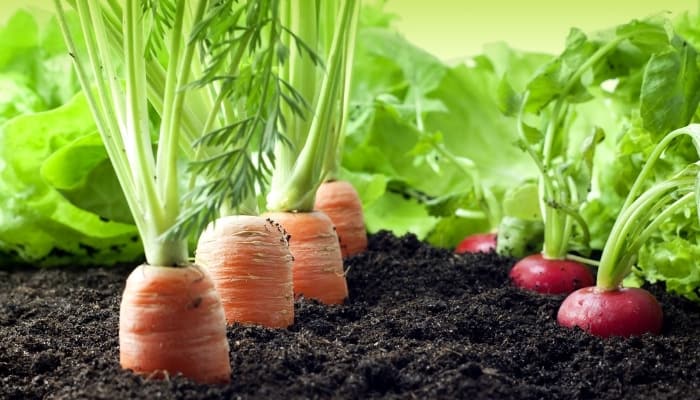No gardener has ever desired to cultivate mediocre or average carrots.
Carrots can take over two months to mature, by which time you’ll want to be rewarded with sweet, earthy-tasting roots and hear that snap-like crunch that denotes quality.
So make sure your garden has your carrots’ back (so to speak) by planting protective and mutually beneficial plants in your patch.
Here are 16 of the best carrot companion crops you can choose from!
1. Tomatoes
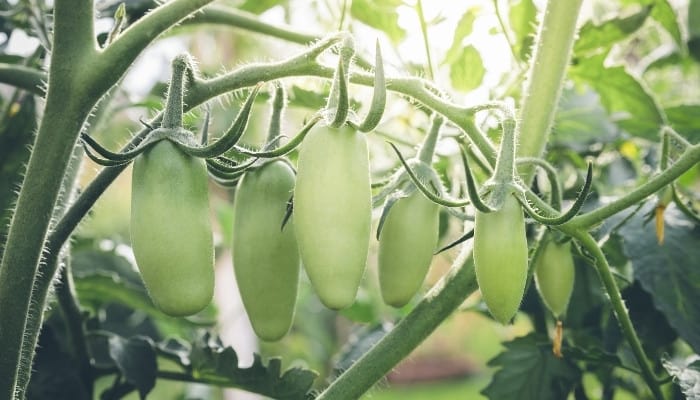
Tomato plants grow between 2 and 6.6 feet high and can grow in either an erect or spreading vine habit.
The plant produces abundant shade-providing leaves and yellow star-shaped flowers that develop into round, smooth-skinned fruit of red, pink, orange, or yellow.
- Benefits provided: The large foliage keeps carrots cool and shaded. Tomatoes also release the chemical solanine – a natural defense mechanism against many garden pests.
- Days until harvest: 60-100+
- Popular varieties: ‘Big Beef’, ‘Juliet’, ‘Sun Gold’, ‘Independence Day’
2. Marigolds
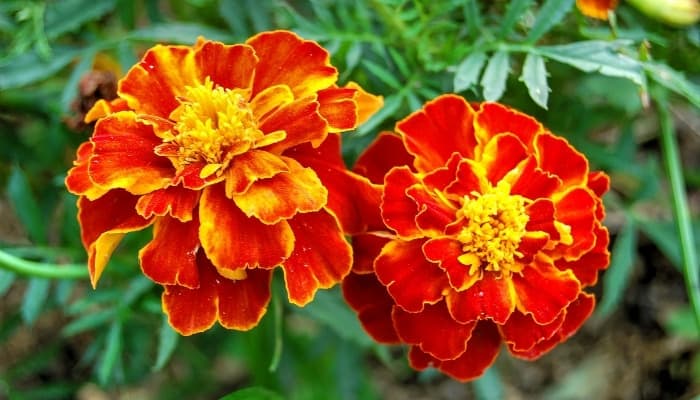
These annual flowers can reach almost 3 feet tall and grow on erect, branched stems or low bushy foliage.
The leaves are dark green in serrated or lance-shaped form, and the globular flower heads produce single/double-flowered petals in shades from pale yellow to orange and mahogany.
- Benefits provided: The strong scent helps to repel greenflies and nematodes. Marigolds also attract beneficial insects like ladybugs and hover flies, which feed on greenflies.
- Days until harvest: 45-50 for cut flowers
- Popular varieties: ‘Cottage Red’, ‘Bon Bon Yellow’, ‘Antigua Orange’, ‘Queen Sophia’
3. Lettuce
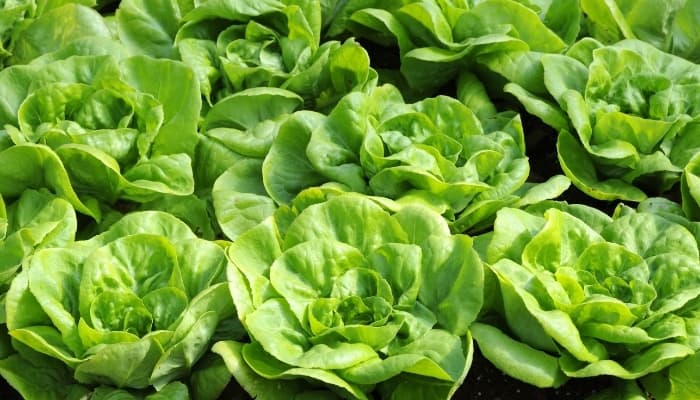
Naraporn Muangwong | Dreamstime
Lettuce plants produce loose or dense rosettes of light-green leaves borne on a short, stubby stem.
This stem lengthens and eventually branches, producing small yellow dandelion-like flower heads if allowed to go to seed.
Lettuce typically grows between 6 and 12 inches tall and 12 inches wide.
- Benefits provided: Compact stem and spreading habit maximizes the available space. Large leaves also protect against weed competition, and both crops love rich soil.
- Days until harvest: 42-70
- Popular varieties: ‘Butterhead’, ‘Romaine’, ‘Crisphead’, ‘Coral Lettuce’
4. Sage
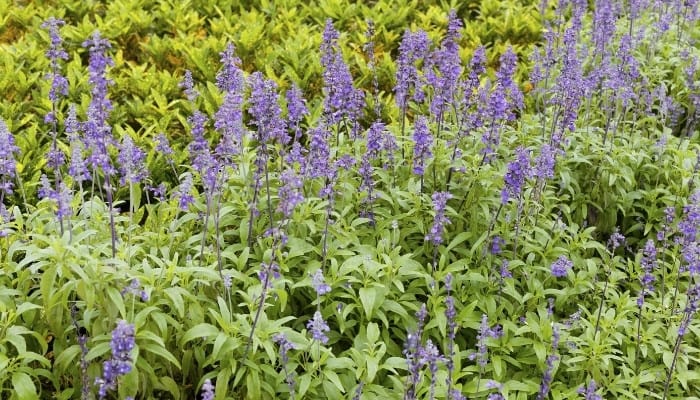
This evergreen shrub usually grows 1 to 2 feet tall and produces downy, oval-shaped leaves on woody stems. The leaves can have a rough or wrinkled texture and are grayish green to whitish green.
Sage also produces spikes of purple, pink, red, and white flowers.
- Benefits provided: Sage masks the smell of carrots to deter carrot root flies. It also attracts pollinators and enhances carrot flavor.
- Days until harvest: 75
- Popular varieties: ‘Greek Sage’, ‘Clary Sage’, ‘Common Sage’, ‘Dalmatian Sage’
5. Onions
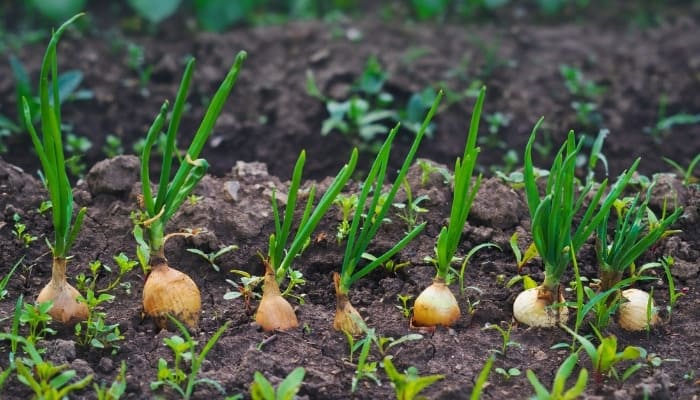
Onion plants can reach 1.6 feet tall and form bulbs protected by thin membranes that form into papery coats.
Overlapping sheaths form a pseudostem from the flat disc-shaped stem, and erect or oblique light green leaves form in clusters, eventually bearing pink/white flowers if not harvested.
- Benefits provided: Not only does the pungent scent deters carrot flies, but both crops appreciate full sun and rich, loose soil. They also share similar harvest times.
- Days until harvest: 100-120
- Popular varieties: Red onions, white onions, Vidalia, ‘Utah Yellow Sweet Spanish’, ‘Italian Torpedo’
6. Garlic
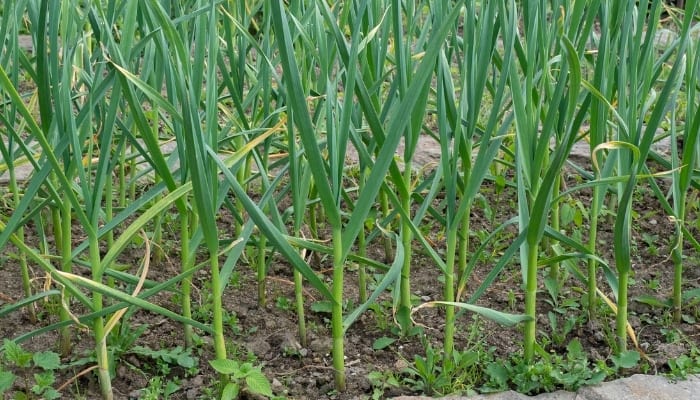
Garlic grows 1.5 to 2 feet tall producing long grass-like leaves of mid-green growing directly from its white to pinkish-tinged flower bulb.
The garlic bulbs contain multiple smaller bulbs (cloves) coated in a protective, papery skin.
- Benefits provided: Its powerful scent deters many pests including carrot flies, aphids, spider mites, and Japanese beetles.
- Days until harvest: 90
- Popular varieties: ‘Northern Garlic’, ‘Porcelain Hardneck’, ‘Rocambole’, ‘Early Purple Wight’
7. Leeks
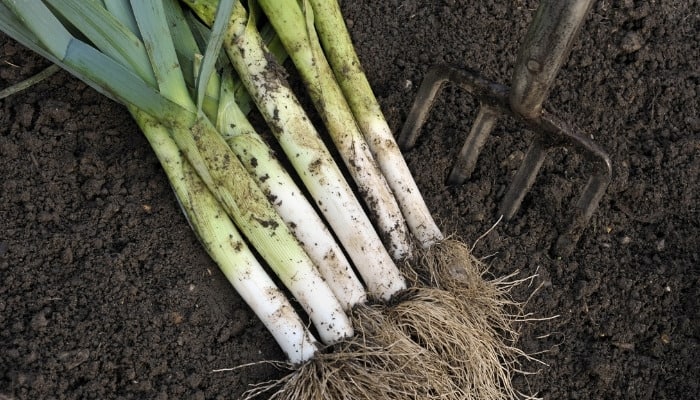
The robust leek plant produces broad and flat gray-green leaves from a sturdy white barrel-shaped stem.
The edible base is actually a multilayered bundle of basal leaf sheaths. Leeks will grow to 1.5 feet tall.
- Benefits provided: Leeks deter carrot flies and help to loosen the soil. Also, both crops love slightly acidic soil and the shallow roots help to maximize growing space.
- Days until harvest: 80-120
- Popular varieties: ‘Autumn Mammoth’, ‘Danish’, ‘Swiss Giant’, ‘Atlantic Leek’
8. Chives
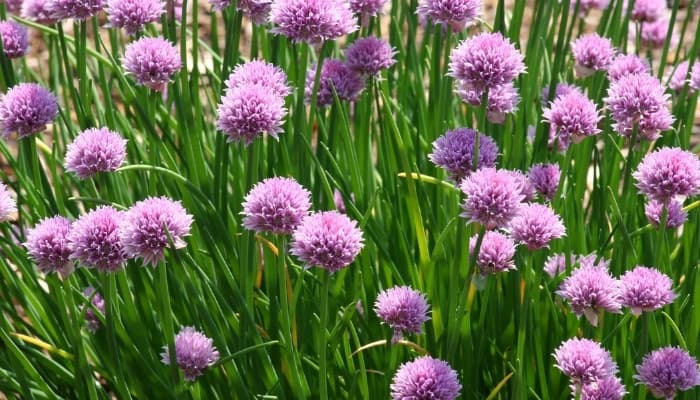
This hardy, drought-tolerant plant grows 1 to 1.6 feet tall and produces tight clusters of slender, funnel-shaped bulbs with long, hollow tubular leaves of dark green growing from the base.
Chive plants also produce rounded onion-like blooms of pink and purple.
- Benefits provided: Chives mask carrot odor to discourage carrot flies, and their shallow roots maximize growth space. Plus, both plants thrive in USDA Zones 3 to 9.
- Days until harvest: 30-60
- Popular varieties: ‘Grolau’, ‘Nelly’, garlic chives, Giant Siberian chives
9. Radish
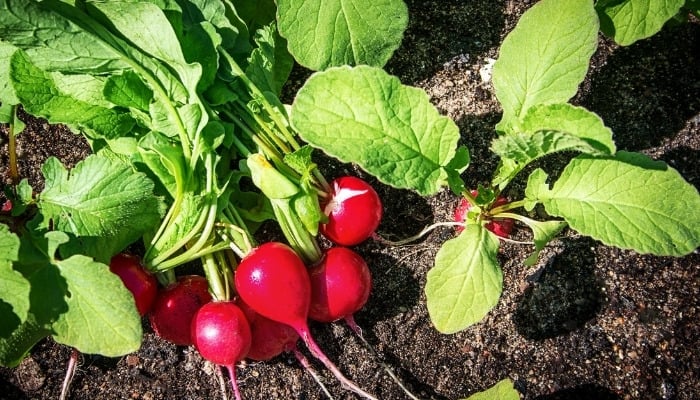
Radishes are plants with an orbital or long tapering taproot, often red or white, and produce a rosette of ground-level oblong-shaped leaves with lance-shaped leaves growing at the top.
Depending on the variety, they can grow between 0.6 to over 3 feet tall
- Benefits provided: Radishes loosen the soil and can be harvested much faster, leaving extra room for carrots to grow.
- Days until harvest: 20-25
- Popular varieties: ‘White Icicle’, ‘Cherry Belle’, ‘Watermelon Radish’, ‘Rougette’
10. Beets
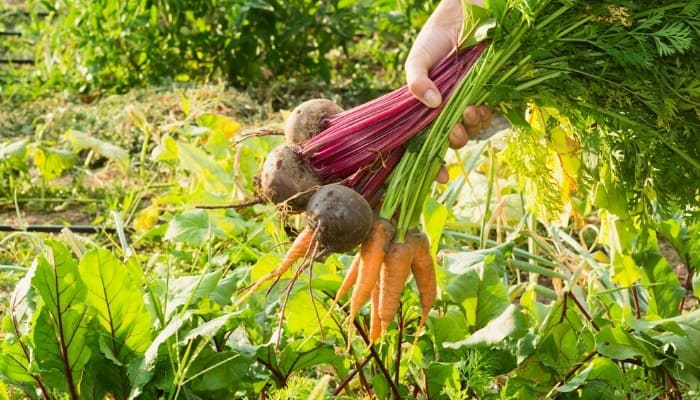
Beets or ‘Beetroot’ plants produce globular or tapered fleshy taproots in colors ranging from white and orange to dark crimson/purplish-red. A rosette of oval mid-green leaves with red midribs grow from erect red stems, reaching between 3.3 to 6.6 ft tall in total.
- Benefits provided: Both crops are cool-season vegetables. Beets are also fast-growers and take up minimal space.
- Days until harvest: 45-65
- Popular varieties: Red beets, golden beets, sugar beets, ‘Avalanche’
11. Nasturtiums
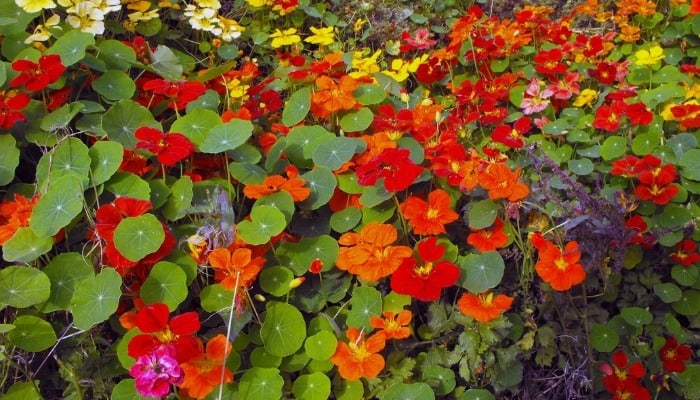
This warm-season and fully edible flowering plant can either form ground cover or trail up to 3 feet tall and features small lily-pad like leaves of deep green.
Bold five-petal flowers bloom in between the foliage, ranging from intense jewel-tone shades to muted pastels.
- Benefits provided: These attract pollinators and serve as an effective trap crop for pesky aphids and beetles. Nasturtiums also enjoy similar sun and soil conditions to carrots.
- Days until harvest: 30-55
- Popular varieties: ‘Jewel’, ‘Alaska’, ‘Whirlybird’, ‘Black Velvet’
12. Beans
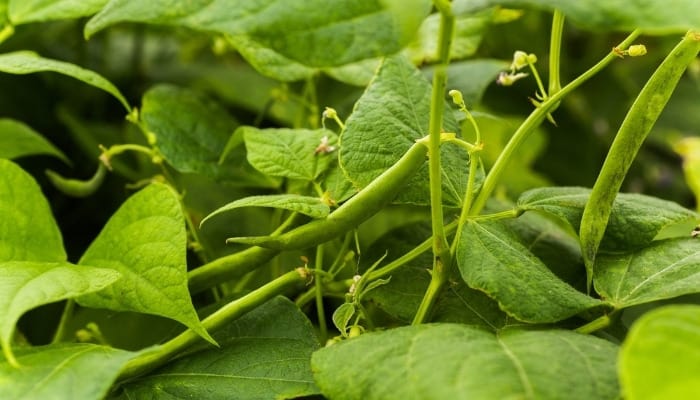
Bean plants vary between erect bushy plants and climbing varieties that can reach between 2 and 15 feet tall, and the vines are covered in large, deep-green heart-shaped leaves.
Edible green pods are produced in varied colors with seeds ranging from flattened to kidney shaped or spherical.
- Benefits provided: Bean plants provide nitrogen-rich soil and attract ladybugs to help keep the green aphids at bay.
- Days until harvest: 50-90
- Popular varieties: Runner bean, lima bean, kidney bean, pinto bean
13. Peas
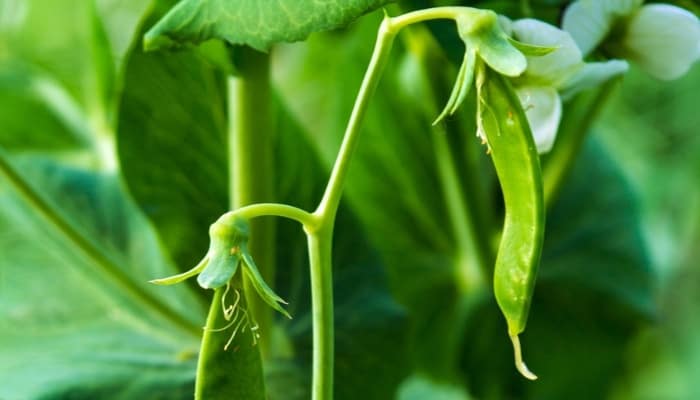
Pea plants can grow to nearly 5 feet tall as either bushy or climbing types.
Oval emerald green leaves grow from slender vines in pairs, featuring compressed green seed pods that can be straight or curved.
- Benefits provided: Peas provide nitrogen-rich soil. Both carrots and peas prosper in moist, cool conditions and mature at similar rates.
- Days until harvest: 77-105
- Popular varieties: Garden sweet, ‘Canoe’, ‘Easy Peasy’, ‘Avola’
14. Kale
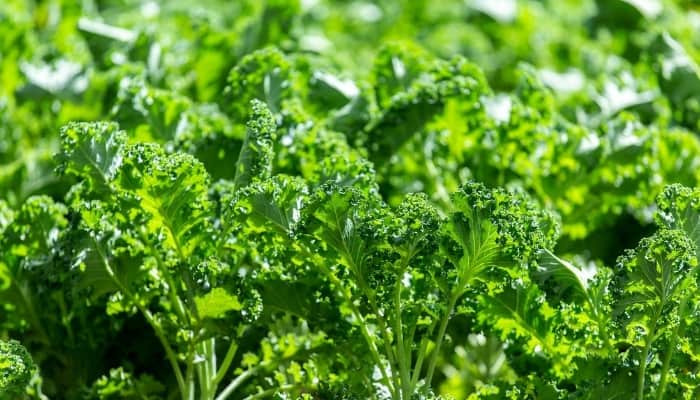
This compact, mound-forming vegetable produces a rosette of long dark green leaves featuring densely frilled and curly edges growing from the central stem.
The central stem of a kale plant can reach 2 feet tall, and leaves can vary between dark or bluish green, red, or purple.
- Benefits provided: Both veggies benefit from light frosts, and like carrots, kale is grown best in nutrient-dense soil
- Days until harvest: 60-75
- Popular varieties: Common curly kale; ‘Tuscan Kale’, ‘Ragged Jack’, ‘Salad Savoy’
15. Amaranth
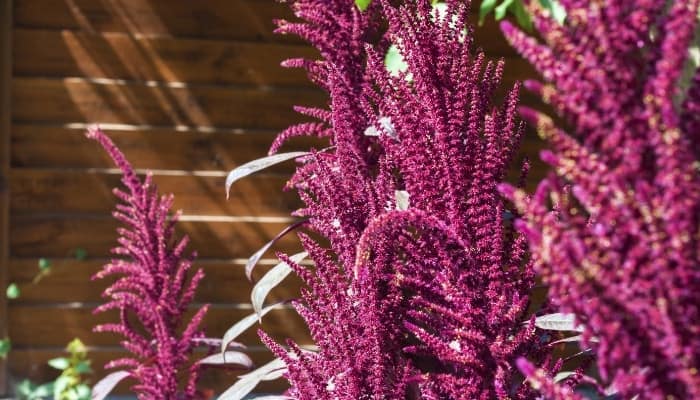
Amaranth are flowering and leaf vegetable plants that can grow between 4 and 6 feet tall with broad, egg-shaped foliage with a smooth or downy texture.
Leaves can be red or light green, producing distinctive erect or pendulous flowering spikes from the center that vary from maroon to deep pink or purple.
- Benefits provided: Amaranth plants help deter many common pests and loosen the soil to better accommodate long carrot roots
- Days until harvest: 90-150
- Popular varieties: Red amaranth, foxtail amaranth, slim amaranth, ‘Prince’s Feather’
16. Rosemary
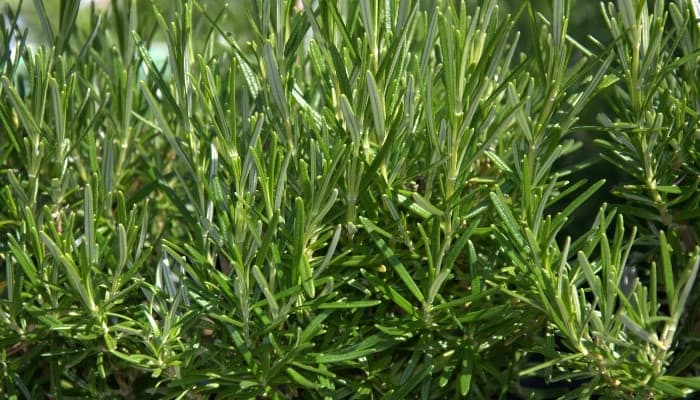
This wonderfully aromatic herb grows in both an upright shrub habit on woody stems or in a trailing, downward form with cascading branches.
Rosemary can grow between 2 and 6 feet tall with a 2 to 5 foot spread producing downy, dark green needle-like leaves and forming clusters of small blue, purple, pink, or white flowers.
- Benefits provided: This herb’s great for masking the smell to fool carrot flies and other pests. Both plants love a full-sun location and well-draining soil, and rosemary’s lovely scent lures in many pollinators like nectar-feeding flies, mason bees, honey bees, and bumblebees.
- Days until harvest: 80-180
- Popular varieties: ‘Barbeque’, ‘Roman’, ‘Tuscan Blue’, ‘Arp’
Final Thoughts
As you can see, there’s a whole host of beneficial plant buddies to pair up with your carrot patch!
These range from crops that will help to keep carrot root flies and other detrimental bugs at bay with their pungent smells to those with soil-loosening qualities and large foliage for added shade.
All that’s left to decide is how you’ll plan your garden layout depending on your space and preference for herbs or flowers (or both).
Happy companion planting!

